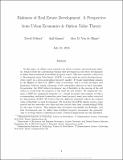| dc.contributor.author | Geltner, David M | |
| dc.contributor.author | Kumar, Anil | |
| dc.contributor.author | van de Minne, Alexander | |
| dc.date.accessioned | 2021-09-03T19:44:20Z | |
| dc.date.available | 2020-08-26T15:33:10Z | |
| dc.date.available | 2021-09-03T19:44:20Z | |
| dc.date.issued | 2018-07 | |
| dc.identifier.issn | 1067-8433 | |
| dc.identifier.uri | https://hdl.handle.net/1721.1/126820.2 | |
| dc.description.abstract | In this article, we define a new construct for urban economic and investment analysis, which revisits the conventional wisdom that investment in real estate development is riskier than investment in stabilized property assets. This new construct, referred as a “development asset value index” (DAVI), is a value index for newly developed properties (only) in a given geographical property market. It tracks longitudinal changes in the highest and best use (HBU) value of locations, and it reveals developer and landowner behavior taking advantage of the optionality inherent in land ownership. In particular, the DAVI reflects developers' use of flexibility in the exercise of the call option to (re)develop the property to any legal use and density. We empirically estimate a DAVI for commercial property (i.e., central locations) and compare it with a corresponding traditional transaction-price-based property asset price index (PAPI) corrected for depreciation. We believe that the difference primarily reflects the realized value of flexibility in land development. We find that the DAVIs display greater value growth and are smoother over time and less cyclical than their corresponding PAPIs for the same locations. This suggests that developers successfully use flexibility, and that development may be riskier than stabilized property investment due primarily only to leverage effects (construction costs). Practical implications are also discussed. | en_US |
| dc.language.iso | en | |
| dc.publisher | Wiley | en_US |
| dc.relation.isversionof | http://dx.doi.org/10.1111/1540-6229.12258 | en_US |
| dc.rights | Creative Commons Attribution-Noncommercial-Share Alike | en_US |
| dc.rights.uri | http://creativecommons.org/licenses/by-nc-sa/4.0/ | en_US |
| dc.source | SSRN | en_US |
| dc.title | Riskiness of Real Estate Development: A Perspective from Urban Economics and Option Value Theory | en_US |
| dc.type | Article | en_US |
| dc.identifier.citation | Geltner, David et al. “Riskiness of Real Estate Development: A Perspective from Urban Economics and Option Value Theory.” Real Estate Economics, 48, 2 (July 2018): 406-445 © 2018 The Author(s) | en_US |
| dc.contributor.department | Massachusetts Institute of Technology. Center for Real Estate | en_US |
| dc.contributor.department | Massachusetts Institute of Technology. Department of Urban Studies and Planning | en_US |
| dc.relation.journal | Real Estate Economics | en_US |
| dc.eprint.version | Author's final manuscript | en_US |
| dc.type.uri | http://purl.org/eprint/type/JournalArticle | en_US |
| eprint.status | http://purl.org/eprint/status/PeerReviewed | en_US |
| dc.date.updated | 2020-08-25T17:32:10Z | |
| dspace.date.submission | 2020-08-25T17:32:12Z | |
| mit.journal.volume | 48 | en_US |
| mit.journal.issue | 2 | en_US |
| mit.license | OPEN_ACCESS_POLICY | |
| mit.metadata.status | Complete | en_US |
